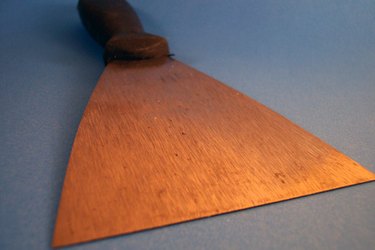Things You'll Need
Floor scraper
Wet/dry shop vacuum
Dish soap
Water

When removing old vinyl sheeting, stubborn glue remnants can remain adhered to the subfloor. The uneven texture caused by the glue remnants makes laying new tile nearly impossible. In order for the new tiles to stay adhered, the subfloor surface must be completely flat. If the subfloor is covered in a layer of textured, uneven adhesive chunks, new tiles will adhere to the glue rather than the subfloor, causing tiles to slip after installation. Although removing remaining glue remnants is somewhat time-consuming, completing this step is vital before applying new flooring.
Step 1
Scrape as much dried adhesive from the subfloor as possible using a metal floor scraper. Much of the glue will flake or crack off.
Video of the Day
Step 2
Vacuum the glue debris with a wet/dry shop vacuum.
Step 3
Soak the remaining glue in a solution of warm water and dish soap. Let the solution sit for a few minutes to soften. Then, use the floor scraper to scrape off the remaining adhesive.
Step 4
Vacuum the wet glue debris with the wet/dry shop vacuum. It is important to use a wet/dry vacuum, since vacuuming up large, wet chunks of adhesive may damage standard vacuum cleaners. Wet/dry shop vacuums are available to rent from most hardware stores.
Step 5
Repeat Steps 3 and 4 until the glue is completely removed.
Tip
Damage to subfloors includes deep gouges, rotting and mold. If a subfloor is severely gouged or has any signs of mold or rot, the section of subfloor must be replaced. Contact a professional to replace subfloor panels.
Video of the Day